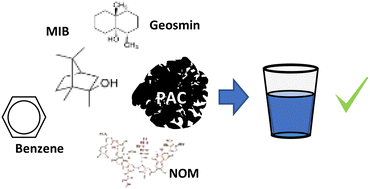Selecting a single powdered activated carbon against multiple threats: taste & odour and benzene†
Abstract
Recurring plans for building a large crude oil pipeline in the immediate neighborhood of the Saint Lawrence River and connected watercourses raise concerns about potential threats to this drinking water source serving over 3 million Canadians. Quebec has the lowest drinking water threshold for benzene in North America (0.5 μg L−1) – a toxic hydrocarbon present in crude oil. With powdered activated carbon (PAC) being an effective benzene adsorbent several municipalities around Montréal consider its application as an emergency barrier. Their current and primary PAC application is taste and odor removal caused by 2-methylisoborneol (MIB) and geosmin. Ideally, a single PAC would be selected as a suitable barrier against all three pollutants. The adsorption of MIB/geosmin was studied on 11 PAC in 3 source waters characterized by different concentrations of low molecular weight natural organic matter – the main competitor for adsorption sites on PAC. Results show that taste and odor removal was low in water with high fractions of small competitive natural organic matter. Benzene removal was studied separately in adsorption tests with 3 selected PAC. The highest (40 to 75%) and the lowest (10 to 15%) benzene removal was achieved by the same PAC types that also performed best and worst respectively for MIB/geosmin.

- This article is part of the themed collection: Recent Open Access Articles


 Please wait while we load your content...
Please wait while we load your content...